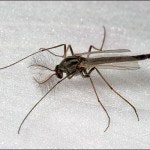Midges- Those Pesky Insects!

June 23, 2023 By Katie Roundtree
Blind mosquitoes, Phantom Midges, Aquatic Midges, No-See-Ums—call them what you will, when they hatch, you’ll know it!
If you live on or near a retention pond or similar body of water in Florida, chances are you are familiar with large swarms of flying insects that inundate your house, yard, & screen room periodically throughout the year, especially in warmer climates such as Texas and Florida. Midge flies belong to a very large and diverse family of aquatic insects. Midges are small, dainty flies with one pair of long, narrow wings, and long, skinny legs. While often thought of as the “cousin” of mosquitoes, midges don’t bite, sting, suck blood or transmit disease. They can, however, become a terrible nuisance and trigger allergies or respiratory issues.
Midges and mosquitoes are often mistaken for each other, which makes sense given that both belong to the order Diptera. The largest difference between the two is that mosquitoes have a proboscis, a mouthpart used to bite and suck blood. Midges do not, and do not bite humans. Otherwise, most of the differences visible to the eye are found in the fine details.
Midges have the following characteristics:
- When landed, fold their first leg pair in a ‘prayer’ position (which can be mistaken for antennae)
- Have long tarsi of foot portions of the forelegs
- Lack scales on their wings, making them smooth
Mosquitoes have the following characteristics:
- When landed, hold their second/back leg pair in the air
- Have scaly wings with a light fringe on their tips
- Typically don’t form swarms
Aquatic midges breed in habitats such as ponds, lakes, waste water treatment plants, and areas with nutrient rich water. Midge flies are a food source for other aquatic insects, such as dragon fly nymphs and several varieties of fish, so the goal is not to completely eliminate them, but to keep them in proper balance within the ecosystem. Areas that receive an excess of lawn fertilizer run-off and very deep, organic lakes tend to be densely populated with midges, particularly with phantom midges. The juvenile stages of development occurs in the water and, upon hatching, large swarms of adults congregate on surfaces of buildings, screens, shrubs, etc. These hatches create severe nuisance problems as they are attracted to light. Spiders form webs in the eaves and around homes to catch midges resulting in excessive cleaning and expense. Midges can get caught up in air conditioning units and cause failure to the unit. Some residents in Florida have complained that allergies and asthma attacks have increased during large midge hatch offs.
Midges have become a prevalent pest over the last few years due to several key factors:
- The number of developments that require storm water systems to prevent flooding has increased.
- High nutrient loads in deep storm water systems is ideal for midge breeding.
- Low dissolved oxygen levels are factors found in deep lakes.
So, what do we do about them? Chemical treatments by a licensed contractor, where applicable, for both larval and adult stages can provide temporary and expensive relief. To get to the root of the problem, the amount of nutrients going into waterbodies must be reduced. This can be achieved by utilizing best management practices while applying fertilizers and managing inflows to the storm water system. Adding oxygen to the storm water system with diffusers and aerators will improve the health of lakes and ponds by increasing dissolved oxygen. By addressing these contributing factors, hatch offs can be greatly reduced. You may want to try lowering your light output at night so the midges are less attracted to your area. Home barrier chemical sprays may also offer some temporary relief.
Thank you to Clarke Aquatic Services and Solitude Lake Management for their contributions to the article.
